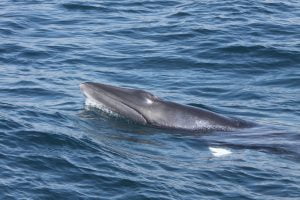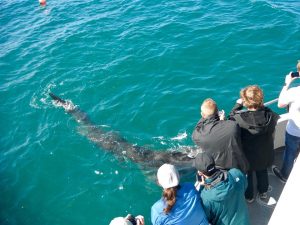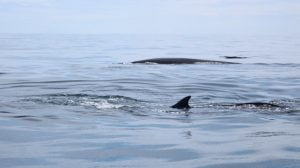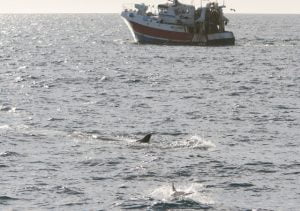Skipper’s log, March 2017.
As the spring of 2017 begins, it must be said that the 2016/17 winter was generally a gentle, benign period of weather, compared to the record breaking rain and flooding of 2015, or the terrible storms of the 2014 winter. With the equinox passed now, and the month of March coming to a close, we are scanning from headlands and vantage points at every opportunity, for the first signs of minke whales returning from their breeding grounds. They will spend the rest of the year here, until December, feeding in Irish waters.
The search for whales is always assisted by the presence of gannets and shearwaters, gathering in numbers, wherever there is any cetacean feeding activity. Gannets are residents in these waters and seen throughout the year, but Manx shearwaters are summer visitors and have just arrived back from the south Atlantic, where they escape the north Atlantic winter. They breed here, around Ireland and Britain, nesting in burrows on offshore, uninhabited islands. They generally head away late October /early November, but this winter, for the first time ever, we saw them in December, January and February. Not in large numbers like the summer months, but some birds seem to have chosen to stay for the winter.
This month is usually the quietest time of year for whale sightings in West Cork waters, but throughout the month we still have regular sightings of two resident cetaceans, common dolphins and harbour porpoises. It is also now that sea temperatures are at their lowest; inshore waters show very little fish shoaling and the sea looks rather barren. But underwater, unseen by human eyes it is a very different story, when most fish species set about their breeding activity. The spawning of most of our fish species is carefully timed to take full advantage of the spring plankton bloom.
With the arrival of the vernal equinox, in the latter part of March, the plankton bursts into life in response to the increasing hours of sunshine that provides the energy for photosynthesis to occur. First, the sea goes green with phytoplankton, the zoo-plankton then flourishes, devouring all this micro plant food, and tiny, newly hatched larval fish and crustacea then flourish in this soup of micro life. Soon the barren looking water is once again full of activity.

Sandeels are the first forage fish to appear inshore. They arrive in large shoals, hungry from the privations of winter, to feed on this new born bonanza of plankton, and with them come their predators- gannets, shearwaters and auks, together with porpoises, common dolphins and minke whales. Sandeel stocks seem to be in good shape here. Unlike sprats, they are not exploited by the fishing industry, and have only their natural predators to contend with. There is a gradual accumulation of sandeels throughout April, and by the start of May sandeel shoals are everywhere, with predators to match. Over the last few years there have been at times, astonishing numbers of minke whales gathered inshore off West Cork in hot pursuit all this food. Some trips in late May 2016 produced regularly betqeen 20-40+ minke whales. All this activity makes for a nice start to our whale watching season.
When I started fishing these waters in 1972, basking sharks were very abundant, and were a real problem when they got snagged in the drift nets we deployed at that time. They are a truly colossal fish, and there were frequent, serious wrestling matches between men, boats and sharks, as we struggled to free them from our nets. I got first-hand experience of the abrasive nature of their skin during one of these skirmishes, and my advice is…. “do not get into a tussle with a basker”. Their skin is coated with a thick blue/black glutinous slime, concealing thousands of tiny thorns that break off and remove the surface of your skin at the same time. It takes weeks to heal up from their abrasions. With no effective teeth, this seems to be their only defence against attack from other predatory sharks or killer whales, and appears to be very effective. I have never seen a basking shark with any kind of bite marks or showing any evidence of predation.

2016 was another good year for basking sharks. They appeared in large numbers all along the West Cork coastline throughout the spring and early summer, all feeding on the rich zoo-plankton bloom. It is a delight to see their numbers holding up so well, given the decline in their numbers over the last couple of decades.
We look forward now to the 2017 season ahead and here’s hoping minke whales and basking sharks will both appear again in the same way, with humpback and fin whales not too far behind them.
Skipper Colin Barnes, Cork Whale Watch,
Reen Pier, near Union Hall, West Cork


